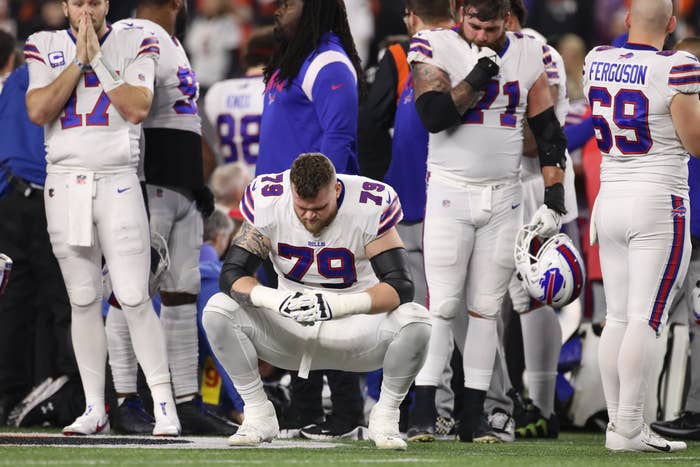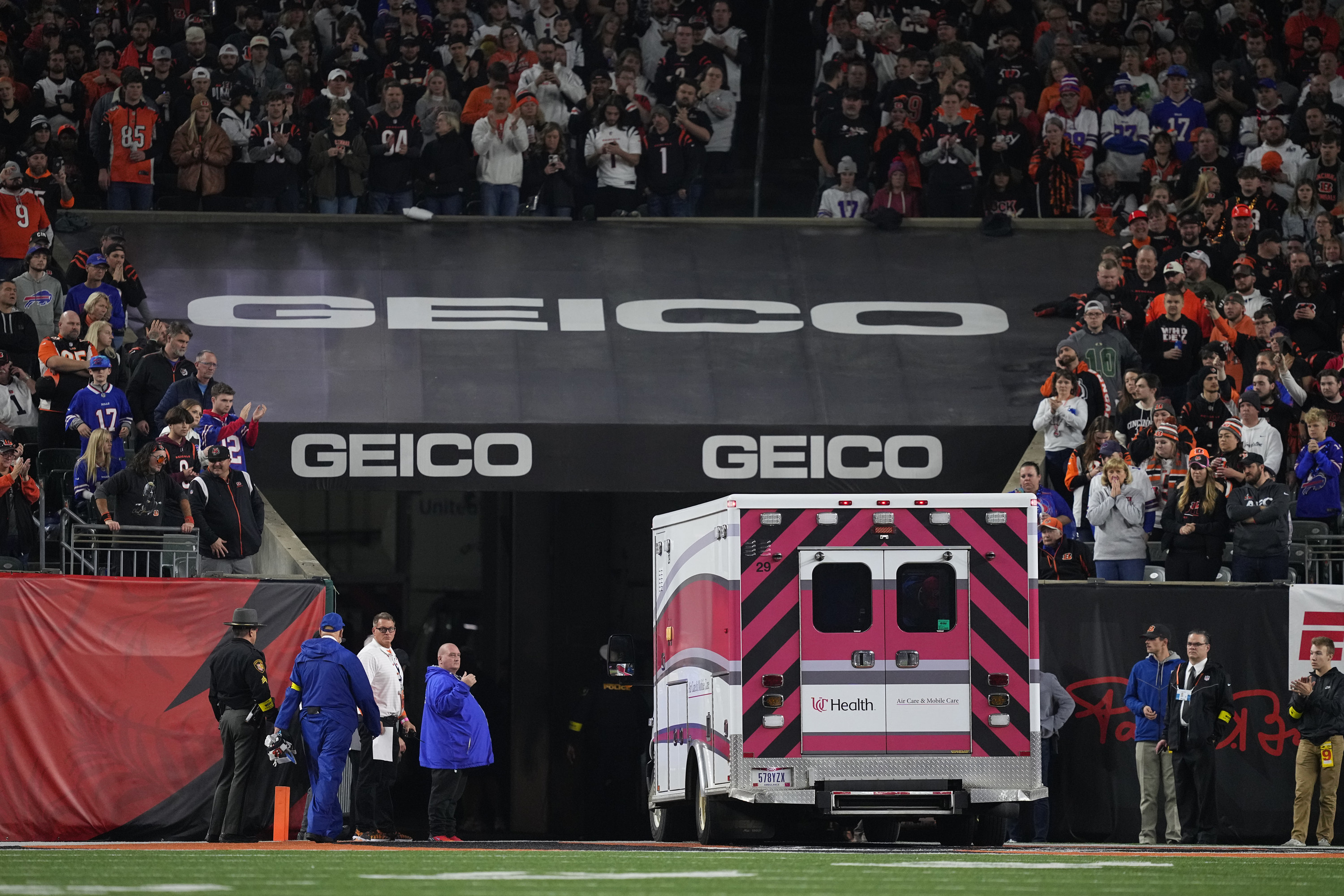
Buffalo Bills safety Damar Hamlin, 24, is in critical condition after experiencing cardiac arrest during a televised game following a tackle, spurring worldwide shock, insensitive conspiracies, and serious discussions about the safety of America’s favorite sport.
After getting hit by Cincinnati Bengals wide receiver Tee Higgins during the first quarter of Monday night’s game, Hamlin stood up and then collapsed backward onto the ground. When medical staff first treated him on the field, Hamlin still had a heartbeat, his team of doctors said during a news conference on Thursday, but he lost it shortly after. CPR and defibrillation — the standard care when a person’s heart stops — occurred "within several minutes," his doctors said, which restored his heartbeat.
Hamlin was sedated at the University of Cincinnati Medical Center’s intensive care unit Monday night.
On Thursday, the Buffalo Bills said Hamlin remains critically ill but that his health is improving; his lungs continue to heal and he's showing signs that he's "neurologically intact," the team tweeted.
Hamlin's doctors said that he became conscious Wednesday night and was following commands from doctors. His first question when he woke up was whether the Bills won the game, the doctors said. (Hamlin still has a breathing tube down his throat, so he is communicating by writing on a piece of paper.)
"Yes, you won," they told Hamlin, even though the game was halted. "You won the game of life.”
The exact cause of Hamlin’s cardiac arrest has not been confirmed as of Thursday afternoon, and cardiologists across the country are hesitant to speculate on what happened without knowing more details, such as how long it took to get his heartbeat back and whether he has any undiagnosed heart condition.
However, knowing that Hamlin’s cardiac arrest occurred moments after a tough hit to the chest, many experts say he may have experienced a rare event called commotio cordis. The condition is life-threatening, but there have been major improvements in survival rates in recent years.
One of Hamlin's physicians, Dr. William Knight, told reporters that commotio cordis is a "diagnosis of exclusion" at this time, "which basically means we have to rule out many other more common, or more deadly, or more fixable-type conditions before we can settle in on an ultimate diagnosis such as that."

What is commotio cordis?
Commotio cordis occurs when a blow, typically from fast-flying objects like baseballs and hockey pucks, to a specific part of the chest happens during a portion of the cardiac cycle that disrupts the heart’s electrical activity. Strikes to the chest during contact sports like karate and football can also trigger the event.
The result is a potentially deadly arrhythmia, or irregular heartbeat, that leads to cardiac arrest. (Cardiac arrest is not the same as a heart attack, which occurs when blood flow to the heart is blocked.) The arrhythmia involved is most often ventricular fibrillation, which is when the lower chambers of the heart contract rapidly, preventing the heart from pumping blood to the rest of the body. (In fact, a study on an anesthetized pig helped researchers learn this.)
Similar to what happened to Hamlin, people experiencing commotio cordis don’t always lose consciousness right away. About 20% of people may be able to continue playing their sport and even talk for a few seconds before collapsing.
It occurs most frequently in male teens playing competitive sports (average age of 15) and is considered to be the second-leading cause of sudden death in young athletes after hypertrophic cardiomyopathy, a disease that causes the heart muscles to thicken, making it harder to pump blood. Data also shows that cases are rising. However, experts believe the increase in diagnoses is due to a greater awareness of commotio cordis that has better prepared people to treat it.
Published research shows that commotio cordis has been reported among players of many sports, including baseball, lacrosse, softball, martial arts, rugby, football, cricket, and hockey — despite the use of protective equipment like chest protectors or softer balls, although the risk is likely lower with these precautions in place.
Still, it’s considered an extremely rare event.
“I've been watching football my whole life and I've never seen this happen. This is so incredibly rare, it’s like winning the Powerball or getting hit by lightning twice,” said Dr. Grant Simons, a cardiac electrophysiologist and chief of heart rhythm services at Hackensack University Medical Center, who watched the Buffalo Bills game live. “There's about a 30th of a second that the heart is even vulnerable to this. So not only does the hit have to be in the right spot on the heart and the right amount of force, it also has to be perfectly timed.”
The most recent study published from the US National Registry of Sudden Death in Athletes in 2016 found that of 2,192 deaths, 58 athletes experienced commotio cordis between 1980 and 2011. The event is reported up to 20 times a year, mostly in the US but in other countries as well.
The last high-profile case involved hockey player Chris Pronger, when a puck hit him on the left side of his chest during the Stanley Cup Playoffs in 1998, leaving him unconscious for about 20 seconds. Pronger returned to the ice four days later.
“Prayers that Damar Hamlin can have the same outcome that I was fortunate to have with my incident,” Pronger tweeted Jan. 3. “Our thoughts and prayers go out to Damar, his family, teammates and the greater NFL community during this incredibly scary time.”
How is commotio cordis treated?
Immediate treatment with CPR and an automated external defibrillator (AED) that delivers electrical shocks to the heart to restore its normal rhythm is absolutely necessary for survival after commotio cordis. Survival rates decline by 10% for every one-minute delay in getting shocked by an AED, according to the Korey Stringer Institute at the University of Connecticut.
Data from a national commotio cordis registry shows that survival rates have been increasing over the last 15 years, reaching nearly 60%. Researchers say greater access to AEDs and better resuscitation training have contributed to the improved survival rates.
Unfortunately, not all people who are resuscitated after commotio cordis fully recover; some are left with brain injuries if treatment wasn’t initiated fast enough.
“Hopefully they shocked him within just a short period of time and were able to do effective compressions to keep his brain supplied with oxygen,” Simons said. “If both of those things are true, then you would hope and expect that he would make a full neurologic recovery and also a full cardiac recovery and not have any long-term functional effects on a part of his brain.”

Are there risk factors that make you more likely to experience commotio cordis?
Because commotio cordis is so rare, there isn’t enough evidence to declare any risk factors for the event that would make someone more likely to experience it, according to Simons, “and there probably never will be,” he said.
It’s possible that Hamlin may have an undiagnosed heart condition that made him more susceptible to cardiac arrest, but Simons said it’s hard to imagine that the rigorous health screenings NFL players go through prior to joining the league, including EKGs and stress tests of the heart, would have missed any major issues. Although, Simons admitted, electrical irregularities in the heart can go undetected in certain tests.
The truth is, there’s not much you can do to reduce your risk of commotio cordis, so there’s no need to remove your kids from youth sports or stop playing recreationally yourself, experts said.
“The thing to remember is that you're more likely to die on a highway than you are playing sports, and the only real prudent thing here is that you should know how to do CPR and call 911,” Simons said.
Could the COVID vaccine have caused Hamlin’s cardiac arrest?
A right-wing conspiracy theory has suggested that a COVID vaccine caused Hamlin’s cardiac arrest, but based on the data, that’s extremely unlikely.
Hamlin’s vaccination status is unknown, but the NFL reported that 95% of its players and nearly 100% of its personnel are vaccinated.
More than 268 million people in the US have received at least one dose of a COVID vaccine, and more than 229 million have completed their primary series; another 47 million have received the updated bivalent booster.
If the vaccine caused Hamlin’s cardiac arrest, there would have been an outbreak of professional athletes’ hearts stopping on the playing field midgame, Simons said. Not to mention, reactions to the vaccine occur most often, if not always, within the week of vaccination.
“It’s like any other medical therapy. They're very few that have absolutely no risk. For example, removing an appendix has a risk, but the fact of the matter is that 999 times out of 1,000, that procedure is more likely to help you than harm you,” Simons said. “It’s the same for the COVID vaccine.”
COVID vaccines have been linked to an increased risk of myocarditis and pericarditis, which is inflammation of the heart muscle and its outer lining, respectively. Symptoms such as shortness of breath, chest pain, and a rapid heartbeat typically emerge within a week of vaccination and occur more often after the second dose.
But several studies have shown that the risks of COVID and its potential long-term effects far outweigh the risks of experiencing an adverse reaction to the vaccine, including myocarditis or pericarditis.
The CDC continues to recommend that everyone 6 months and older get vaccinated against COVID.
UPDATE
This story includes an update on Damar Hamlin's health status.
